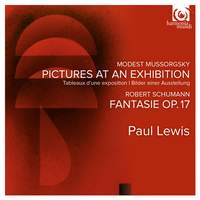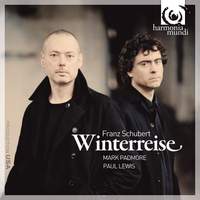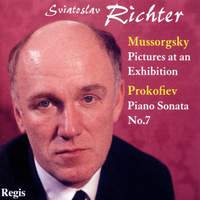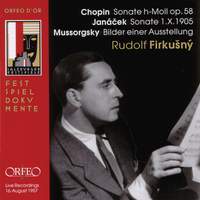Interview,
A trip to the gallery with Paul Lewis.
 In the wake of his landmark traversals of Beethoven and Schubert, Paul Lewis spent much of last year reconnecting with the Russian Romantic repertoire that he loved as a very young pianist: his live recitals of Mussorgsky's Pictures at an Exhibition garnered stellar reviews across the board, with The Guardian describing a performance at St George's Bristol as 'resonant and ultimately very powerful' and the New York Times praising the 'myriad distinctive touches and nuances' displayed in the Carnegie Hall concert.
In the wake of his landmark traversals of Beethoven and Schubert, Paul Lewis spent much of last year reconnecting with the Russian Romantic repertoire that he loved as a very young pianist: his live recitals of Mussorgsky's Pictures at an Exhibition garnered stellar reviews across the board, with The Guardian describing a performance at St George's Bristol as 'resonant and ultimately very powerful' and the New York Times praising the 'myriad distinctive touches and nuances' displayed in the Carnegie Hall concert.
Shortly before the release of his recording of Pictures and the Schumann Fantasie, I shot him a few questions about his relationship with the cycle and the challenges involved in returning to the original version of a work that's become well known in various orchestrations…
Tell us a little about your relationship with Pictures - you've been performing the work around the UK quite a lot this past year, but when did you first encounter it, and did any particular recording (either of the orchestral of piano versions) shape your interpretation in any way?
I can't remember exactly, but I think I first encountered Pictures around the age of 11 or 12 on a visit to the local record library. The first recording I got to know was Alfred Brendel's early performance on Turnabout, after which I remember listening to recordings by Rudolf Firkusny (a wonderful performance), along with the famous versions by Richter and Horowitz. I don't think any of them have had a major influence on my approach to be honest, although it's very easy for elements of performances one hears to find their way into your own interpretation - which is why I deliberately avoid listening to recordings of pieces I'm working on at the time.
How much are you influenced by the Ravel (or other) orchestral versions? Do you consciously seek to replicate colours and sonorities from existing orchestrations, or start with a blank slate?
There are so many wonderful and inspiring things in the Ravel orchestration, as well as others, but I don't think one should take a composer's orchestration of Pictures as a basis for creating orchestral colours, as it's really all there in the piano writing in the first place. Mussorgsky's ability to find those orchestral colours from within the piano is quite extraordinary and, in my opinion, is the reason why so many have chosen to orchestrate the work. It makes me think of the Wanderer Fantasy, Schubert's most orchestral sounding solo piano work. Liszt hardly needed to orchestrate it in order to emphasise its symphonic nature, but the fact that the work lends itself naturally to an orchestral/concerto format must have made it hard to resist transcribing. Similarly, Pictures doesn't need an orchestration to bring those colours to life - a good performance linked to a vivid imagination should be able to achieve that!
If it's not too ephemeral a question, where do you stand on the 'absolute music' debate? How directly do you draw on extra-musical sources for inspiration when getting to know repertoire which has a basis in literature or the visual arts?
It's a difficult one… Listeners inevitably have their own idea of how music relates to a literary or visual work, which may be very different from the idea of the person performing it. I don't think there's anything wrong at all in having a strong visual sense where music is concerned. In a way, it's all part of the pleasure of enjoying music, and in the case of a piece like Pictures which has clearly been inspired by such things, how could you not? In my view there are many composers for whom it is essential to have some form of extra musical source informing one's approach to their work, such as Schumann for example. Which leads us on to the next question...
What was behind the decision to pair Pictures with the Schumann Fantasie?
Well, partly that sense of the extra-musical discussed in the last question! For me, both works have an incredibly strong visual feeling about them, even if the Schumann isn't as explicit in that regard as the Mussorgsky. I also feel that the two pieces share some common ground in that they're both fundamentally impulsive works, yet despite their frequent changes of emotional direction and character they still rely on an underlying sense of line and continuity. For me, that's the challenge of both these works - the characterisation is the fun part, making it all add up at the same time is more complex!
What prompted your move to Russian repertoire after all the focus on single Austro-Germanic composers (and will there be more?!)?
I just think it's a great piece, and had wanted to play it for a long time. I used to play much more Russian music when I was in my teens and twenties, and have recently started looking back at some of that, so yes there may well be more!
Paul Lewis's recital of Mussorgsky and Schumann was released on Monday on Harmonia Mundi.
Available Formats: CD, MP3, FLAC, Hi-Res FLAC
Selected recordings by Paul Lewis
(You can browse his full available discography here.)
This instalment of Lewis's Schubert series won widespread acclaim on its release in autumn 2012: 'If one were ever tempted to say a recording was 'definitive' then this is the time' (BBC Music Magazine).
Available Formats: MP3, FLAC, Hi-Res FLAC
Lewis's Winter Journey with tenor Mark Padmore won the Solo Vocal category at the 2010 Gramophone Awards, with The Independent observing that 'The balance between voice and piano is exceptional, the interpretation bold and complex'.
Available Formats: MP3, FLAC
Recorded between July 2009 and March 2010 (shortly before Lewis became the first pianist to perform all five concertos at the BBC Proms in one season), these accounts with Jiri Belohlávek and the BBC Symphony Orchestra were described by International Record Review as 'imaginative and responsive to the shifting moods of the music in these concertos, as well as technically impeccable'.
Available Formats: MP3, FLAC, Hi-Res FLAC
Referenced recordings of Pictures on piano
Sviatoslav Richter, recorded in 1957; mono sound.
Available Formats: CD, MP3, FLAC
Rudolf Firkusny, recorded the same year at the Salzburg Festival.
Available Formats: CD, MP3, FLAC
'Only 'The Great Gate of Kiev' makes it onto this Carnegie Hall boxed set of Vladimir Horowitz recordings, but it goes without saying that it's well worth hearing!
Available Formats: MP3, FLAC









